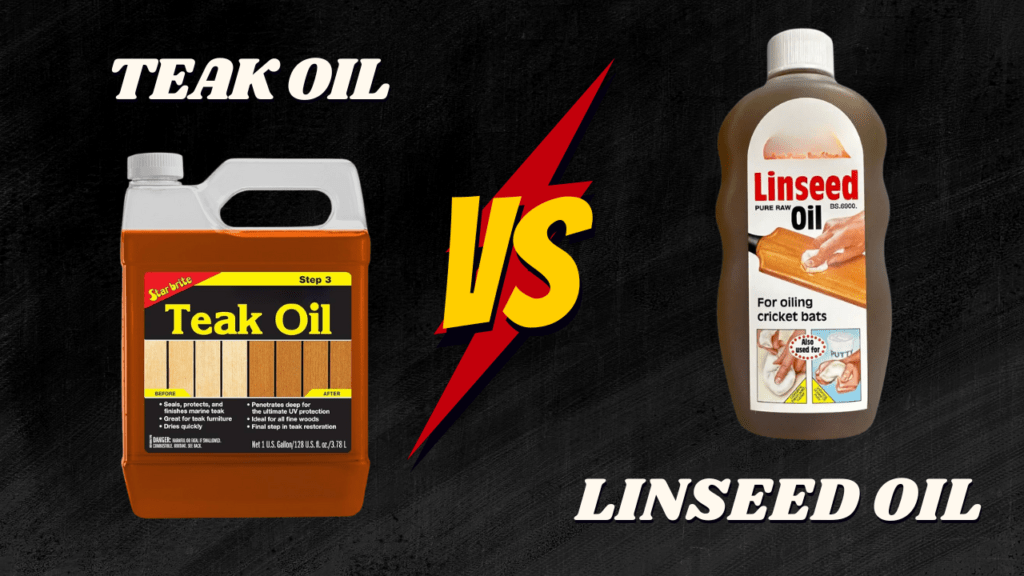
When it comes to natural wood finishes, two popular options are teak oil and linseed oil. Both are widely used to enhance the natural grain of wood, provide protection, and extend the lifespan of wooden furniture. However, their composition, appearance, and durability differ, making each more suitable for specific applications.
This guide compares teak oil vs linseed oil in detail, explaining their benefits, drawbacks, and uses so the right choice can be made for woodworking projects.
What Is Teak Oil?
Despite its name, the teak oil is not extracted from the teak wood. Instead, it is a blend of oils (often tung or linseed), varnish, and solvents formulated to protect hardwoods like teak, mahogany, and rosewood.
- Composition: A mix of natural oils and resins with added drying agents.
- Appearance: It produces a warm, rich finish that enhances the wood’s natural grain with a low to medium sheen.
- Durability: Offers good protection against moisture, stains, and UV rays, making it suitable for indoor and outdoor use.
- Drying Time: Dries faster than raw linseed oil, typically within 6–24 hours between coats.
- Best Uses: Commonly used for outdoor furniture, boats, and hardwoods exposed to weather and sunlight.
What Is Linseed Oil?
Linseed oil is a natural oil which we get from pressing the flax seeds and has been used for centuries as a protective finish for wood.
- Types of linseed oil:
- Raw linseed oil: 100% natural, food-safe, but extremely slow to dry (weeks).
- Boiled linseed oil (BLO): Contains chemical drying agents, cures faster, but not food-safe.
- Polymerized linseed oil: Heat-treated without additives, dries within 1–2 days, and is food-safe.
- Appearance: Adds a warm golden tone to wood with a satin finish, though it may yellow or darken over time.
- Durability: Provides moderate water and wear resistance but less protection than blended oils like teak oil.
- Best Uses: Suitable for indoor furniture, decorative wood, and food-contact items (when raw or polymerized is used).
Teak Oil vs Linseed Oil: Key Differences
| Feature | Teak Oil | Linseed Oil (Raw / Boiled / Polymerized) |
|---|---|---|
| Composition | Blend of oils, varnish, and solvents | Pure flaxseed oil (raw, boiled, or polymerized) |
| Drying Time | 6–24 hours | Raw: weeks; Polymerized: 1–2 days; BLO: ~1 day |
| Finish | Enhances grain with rich, warm glow | Satin finish, golden tint, yellows with age |
| Durability | Stronger, weather-resistant, UV protection | Moderate, less resistant to elements |
| Food-Safe | Not food-safe | Raw & polymerized safe; BLO not recommended |
| Best For | Outdoor furniture, boats, hardwoods | Indoor furniture, utensils, antique restoration |
| Maintenance | Needs reapplication every few months outdoors | Needs frequent reapplication indoors |
Which Oil Should Be Chosen?
- Teak oil should be chosen for outdoor furniture and hardwoods, where moisture and sunlight protection are priorities. Its blend of resins and oils provides better durability against the elements.
- Linseed oil should be selected for indoor projects where a natural, traditional finish is desired, particularly for antique restoration or food-safe applications.
Advantages of Teak Oil
- Provides strong protection against UV rays and moisture
- Enhances hardwood grain with a rich glow
- Faster drying compared to raw linseed oil
- Suitable for both indoor and outdoor projects
- Easy to reapply for ongoing maintenance
Advantages of Linseed Oil
- 100% natural in raw and polymerized forms
- Deeply penetrates wood fibers for a rich, classic finish
- Affordable and widely available
- Safe for food-contact items (except BLO)
- Ideal for antique and traditional wood finishes
Common Uses of Teak Oil
- Outdoor furniture (teak, mahogany, acacia, etc.)
- Wooden boats and decks
- Patio furniture and hardwood flooring
- Decorative hardwoods exposed to sunlight
- Garden benches and outdoor trim
Common Uses of Linseed Oil
- Cutting boards, bowls, and utensils (raw/polymerized)
- Antique furniture restoration
- Indoor furniture and decorative items
- Wood tools and musical instruments
- Interior wood paneling and crafts
Frequently Asked Questions (FAQs)
1. Is teak oil better than linseed oil?
Teak oil is more durable and weather-resistant, making it better for outdoor projects, while linseed oil is ideal for indoor, food-safe finishes.
2. Can teak oil be used on all types of wood?
Yes, but it is particularly effective on hardwoods like teak, mahogany, and rosewood that are dense and used outdoors.
3. Does linseed oil make wood waterproof?
Linseed oil offers some water resistance but does not make wood fully waterproof. Regular reapplication is required.
4. Is teak oil food-safe?
No, teak oil blends are not food-safe and should not be used on cutting boards, bowls, or utensils.
5. Which oil lasts longer outdoors?
Teak oil lasts longer outdoors due to its added resins and UV protection, while linseed oil breaks down faster under sunlight and moisture.
6. Can teak oil be applied over linseed oil?
It is not recommended, as linseed oil penetrates deeply and may prevent teak oil from bonding properly.
Final Thoughts:
The choice between teak oil vs linseed oil depends on the intended project. Teak oil is the superior option for outdoor furniture and hardwoods exposed to sunlight and moisture, thanks to its durability and UV protection. Linseed oil, on the other hand, is better for indoor applications, traditional finishes, and food-safe wood care.
By evaluating the specific needs of a project, woodworkers can select the right oil finish to enhance beauty, extend durability, and maintain the natural charm of wood.

